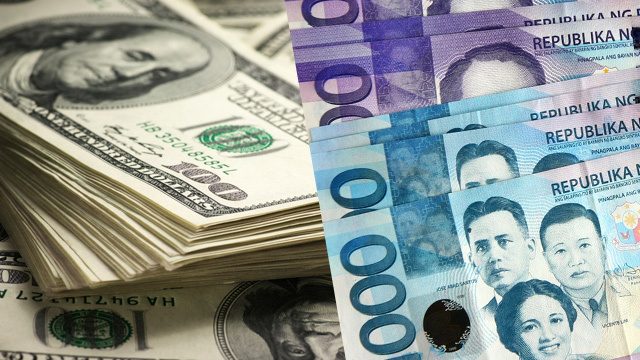SUMMARY
This is AI generated summarization, which may have errors. For context, always refer to the full article.

MANILA, Philippines – The Philippine peso weakened to a near nine-month low, almost touching the P57 level against the US dollar on Monday, August 14, amid headwinds such as higher global oil prices and interest rates.
This is the eighth straight day that the peso has depreciated, falling to as low as P56.99 before closing at P56.78 against the dollar. The last time the local currency saw this weakness was on November 23, 2022, when it closed at P56.94.
Volume declined by 1.5% to $1.4 billion on Monday from $1.43 billion last Friday, August 11.
Rizal Commercial Banking Corporation chief economist Michael Ricafort said the movement occurred after global crude oil prices hovered at around the highest in nine months, indicating further uptick in prices of other goods on top of a larger import bill and a wider trade deficit.
Ricafort also noted that global rice prices have reached 15-year highs, which may lead to a pickup in overall inflation. (READ: [ANALYSIS] Yet another massive rice crisis)
The 10-year United States Treasury yield has also gone up to a nine-month high of 4.16%, placing pressure on borrowing costs of some local companies and increasing the attractiveness of the US currency.
The peso is also slightly weaker after the Philippine Stock Exchange index declined for the third consecutive trading day, closing at 6,329, a nine-month low since November 15, 2022.
‘In the middle’
In an economic briefing in Laoag City, Ilocos Norte, on Monday, Bangko Sentral ng Pilipinas Governor Eli Remolona Jr. said the peso’s decline of 0.86% year-to-date is “somewhere in the middle.”
“Compared to our neighbors, the peso has weakened only slightly,” he said.
The Japanese yen has posted the sharpest decline, falling 8.35% so far this year, followed by the New Zealand dollar (4.52%), Chinese yuan (4.35%), South Korean won (4.24%), Australian dollar (4.23%), Malaysian ringgit (3.77%), Taiwanese dollar (3.37%), Thai baht (1.09%), and then the Philippine peso.
After the peso are the Singaporean dollar (0.42%), Vietnamese dong (0.40%), and Indian rupee (0.07%).

The depreciation of the peso against the greenback was also due to the US Federal Reserve’s decision to raise key policy rates by another 25 basis points and Fitch Ratings’ move to downgrade the credit rating of the US to AA+ from AAA.
Remolona added that the Philippines has ample foreign exchange buffers to stabilize the local currency. Remittances from overseas Filipino workers and foreign direct investments will build up the country’s reserves, according to the central bank chief.

“Our reserves have hovered around $100 billion. We expect it to remain at roughly the same level in the coming years. We need these reserves because we think the world will slow down next year and the following years especially because of what the Fed has done,” he said. – Rappler.com
Add a comment
How does this make you feel?
![[EDITORIAL] Apat na taon na lang Ginoong Marcos, ‘di na puwede ang papetiks-petiks](https://www.rappler.com/tachyon/2024/07/animated-bongbong-marcos-2024-sona-day-carousel.jpg?resize=257%2C257&crop=280px%2C0px%2C720px%2C720px)
![[In This Economy] Delulunomics: Kailan magiging upper-middle income country ang Pilipinas?](https://www.rappler.com/tachyon/2024/07/in-this-economy-upper-middle-income-country.jpg?resize=257%2C257&crop=421px%2C0px%2C1080px%2C1080px)

![[EDITORIAL] Marcos Year 2: Hilong-talilong](https://www.rappler.com/tachyon/2024/07/animated-bongbong-marcos-2nd-sona-carousel.jpg?resize=257%2C257&crop=136px%2C0px%2C720px%2C720px)
![[Newspoint] A fighting presence](https://www.rappler.com/tachyon/2024/07/thought-leaders-a-fighting-presence.jpg?resize=257%2C257&crop=441px%2C0px%2C1080px%2C1080px)
There are no comments yet. Add your comment to start the conversation.